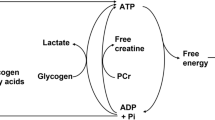Summary
To characterize more precisely the relationship between ventilation (V E) and CO2 output (VCO2) during incremental exercise, 35 healthy males were studied at rest and during upright cycle ergometry, with the work rate incremented every 4 min up to each subject's anaerobic threshold (θ an). Twenty-one subjects had arterial blood sampled at rest and in the steady state at each work rate to determine the relationship between physiological dead space ventilation (V D) and VCO2. At these work rates arterial PCO2 was regulated at the resting, control value. V E (BTPS) was linearly related to VCO2 from rest to θ an with a slope of 24.6. However, the regression had a significant positive intercept of 3.2 L·min−1. This causes the ventilatory equivalent for CO2 (i.e., V E/VCO2) to decrease with increasing work rates. V D also increased linearly with increasing VCO2. However, this was consequent to increased breathing frequency as V D remained constant. Thus, the observed fall in V E/VCO2 with increasing work rates is due to the positive intercept but the inherent relationship between V E and VCO2, reflected by the linear regression slope, remains unchanged from rest through moderate exercise.
Similar content being viewed by others
References
Asmussen E, Nielsen M (1947) Studies on the regulation of respiration in heavy work. Acta Physiol Scand 12:171–187
Asmussen E, Nielsen M (1956) Physiological dead space and alveolar gas pressure at rest and during muscular work. Acta Physiol Scand 38:1–21
Beaver WL, Wasserman K, Whipp BJ (1973) On-line computer analysis and breath-by-breath graphical display of exercise function tests. J Appl Physiol 34:128–132
Cunningham DJC (1974) Integrative aspects of the regulation of breathing: a personal view. In: Widdicombe JG (ed) MTP international review of science: respiratory physiology, series 1, vol 2. London, Butterworths, pp 303–369
Filley GF, Heineken FG (1976) A blood gas disequilibrium theory. Br J Dis Chest 70:223–245
Gray JS, Grodins FS, Carter ET (1956) Alveolar and total ventilation and the dead space problem. J Appl Physiol 9:307–320
Grodins FS (1950) Analysis of factors concerned in the regulation of breathing in exercise. Physiol Rev 30:220–239
Hansen JE, Stelter GP, Vogel JA (1967) Arterial pyruvate, lactate, pH, and PCO2 during work at sea level and high altitude. J Appl Physiol 23:523–530
Hesser CM, Linnarsson D, Bjurstedt H (1977) Cardiorespiratory and metabolic responses to positive, negative, and minimum-load dynamic leg exercise. Respir Physiol 30:51–67
Jones NL (1976) Use of exercise in testing respiratory control mechanisms. Chest 70:169–173
Jones NL, McHardy GJR, Naimark A, Campbell EJM (1966) Physiological dead space and alveolararterial gas pressure differences during exercise. Clin Sci 31:19–29
Lenox JB, Koegel E (1974) Evaluation of a new low resistance breathing valve. J Appl Physiol 37:410–413
Turino GM, Cugell DW, Goldring RM, Jones NL, Mellins RG, Nadel JA, Wasserman K (1977) Workshop on assessment of respiratory control in humans: VI. The use of exercise to study ventilatory control. Am Rev Respir Dis 115:715–716
Wasserman K (1976) Testing regulation of ventilation with exercise. Chest 70:173–178
Wasserman K, Van Kessel AL, Burton GG (1967) Interaction of physiological mechanisms during exercise. J Appl Physiol 22:71–85
Wasserman K, Whipp BJ, Koyal SN, Beaver WL (1973) Anaerobic threshold and respiratory gas exchange during exercise. J Appl Physiol 35:236–243
Whipp BJ (1980) The control of exercise hypernea. In: Hornbein T (ed) The regulation of breathing. Dekker, New York (in press)
Whipp BJ, Wasserman K (1969) Alveolar-arterial gas tension differences during graded exercise. J Appl Physiol 27:361–365
Author information
Authors and Affiliations
Additional information
This investigation was supported by National Institutes of Health Grant HL-11907
Rights and permissions
About this article
Cite this article
Davis, J.A., Whipp, B.J. & Wasserman, K. The relation of ventilation to metabolic rate during moderate exercise in man. Europ. J. Appl. Physiol. 44, 97–108 (1980). https://doi.org/10.1007/BF00421087
Accepted:
Issue Date:
DOI: https://doi.org/10.1007/BF00421087




